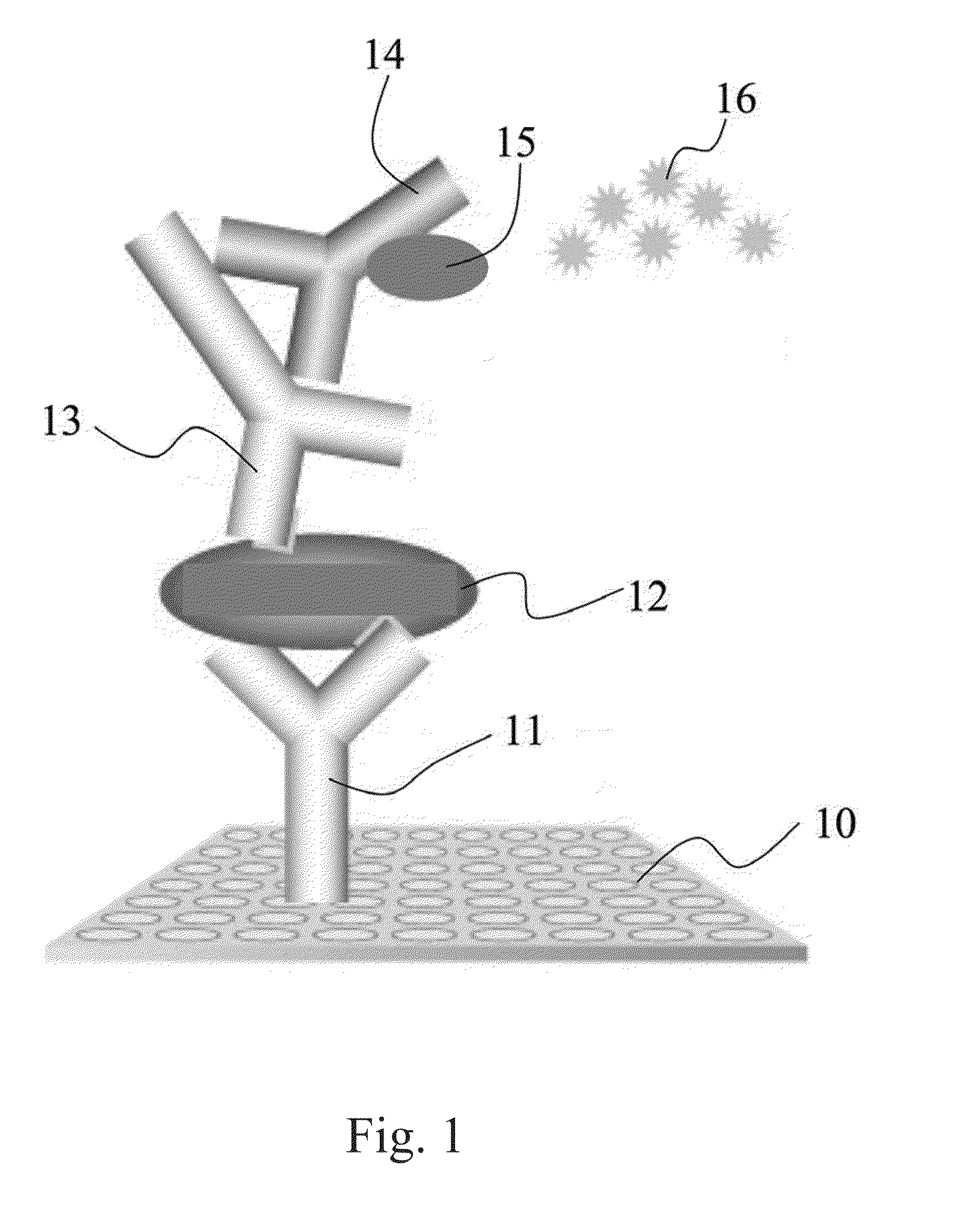Hybridoma cell line producing monoclonal antibody against foot-and-mouth disease virus, the monoclonal antibody therefrom, immunoassay reagent and kit, and immunoassay method
a cell line and monoclonal antibody technology, applied in the field of hybridoma cell line producing monoclonal antibody against foot and mouth disease virus, can solve the problems of lack of bovine susceptibility, large economic loss, and inability to provide cross protection of serotypes
- Summary
- Abstract
- Description
- Claims
- Application Information
AI Technical Summary
Benefits of technology
Problems solved by technology
Method used
Image
Examples
experiment 1
Materials and Methods
1.1: Serum
[0045]To evaluate the sensitivity of immunoassays, 32 FMD-positive swine serum samples were collected from 8-week-old swine on the 34th days after the swine's experimental infection with the O / TAW / 97 FMDV strain.
[0046]To compare the sandwich ELISA immunoassay kit of the present invention with three commercially available ELISA immunoassay kits, a total of 320 serum samples were collected from 32 specific-pathogen-free (SPF) swine which had been experimentally infected with the O / TAW / 97 FMDV strain. The 320 serum samples were collected on the 0th day, 2nd day, 4th day, 6th day, 8th day, 10th day, 14th day, 21st day, 28th day, and 34th day after the swine's experimental infection with the O / TAW / 97 FMDV strain. In addition, 30 serum samples were collected from swine infected with the O / TAW / 97 FMDV strain on the 28th day after the swine's experimental infection.
[0047]To assay specificity, 255 serum samples were collected from uninfected swine, and 165 seru...
experiment 2
3ABC Recombinant Protein Expressed by E. coli
[0059]The 3ABC genetic sequence of the O / TAW / 99 FMDV was obtained from the GenBank of the National Center for Biotechnology Information (NCBI) of the United States. See SEQ ID NO:1 for a detailed sequence of nucleotide regions No. 5595 to No. 6119 of GenBank accession No. AJ539137, which includes a coding region with a length of 525 nucleotides, and thus the recombinant protein coded thereby is composed of 175 amino acids (of a sequence shown in SEQ ID NO:2). A comparison of the genetic sequences of Pan-Asia serotype O FMDV strains recently isolated from Asia, Africa, and Europe shows approximately 97% to 99% genetic identity.
[0060]A primer pair was designed to amplify a nucleic acid fragment of the 3ABC gene region. The sequence of the forward primer is as follows: 5′-CACCGGATCCTGTCGCGAGACTCGCAAGAGACAGCAG-3′, which includes a restriction site for the BamHI restriction enzyme. The sequence of the reverse primer is as follows: 5′-CCCGAATT...
experiment 3
Mouse Immunization and Production of Anti-3ABC Monoclonal Antibody
[0063]A hybridoma cell line producing an anti-3ABC recombinant protein monoclonal antibody was produced in the following manner. As an antigen, 200 μg of the 3ABC recombinant protein produced in Experiment 1.5 was administered, by hypodermal injection, to a BALB / c mouse to immunize the BALB / c mouse. The interval of immunization was four weeks. Three to four days before cell fusion, the same amount of the antigen was added to a PBS, and the antigen-containing PBS was administered, by hypodermal injection, to the mouse as a boost injection. Afterward, the immunized BALB / c mouse was humanely killed, and the spleen was removed from the carcass. A splenocyte isolated from the spleen underwent cell fusion with the Sp2 / 0 myeloma cell line, thereby producing the hybridoma cell. Two weeks later, the culture supernatant of the hybridoma cell was screened by indirect ELISA, which contained O / TAW / 97 or O / TAW / 99 FMDV recombinant p...
PUM
| Property | Measurement | Unit |
|---|---|---|
| wavelength | aaaaa | aaaaa |
| concentration | aaaaa | aaaaa |
| pH | aaaaa | aaaaa |
Abstract
Description
Claims
Application Information
 Login to View More
Login to View More - R&D
- Intellectual Property
- Life Sciences
- Materials
- Tech Scout
- Unparalleled Data Quality
- Higher Quality Content
- 60% Fewer Hallucinations
Browse by: Latest US Patents, China's latest patents, Technical Efficacy Thesaurus, Application Domain, Technology Topic, Popular Technical Reports.
© 2025 PatSnap. All rights reserved.Legal|Privacy policy|Modern Slavery Act Transparency Statement|Sitemap|About US| Contact US: help@patsnap.com

